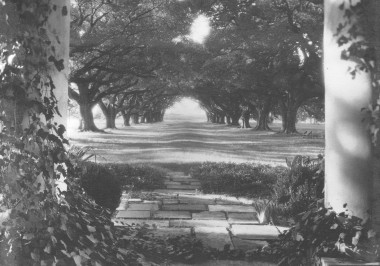Oak Alley takes its name from a row of 28 live oak trees (Quercus virginiana), native to this region. Stretching from the mansion to the Mississippi River, they have witnessed the evolution of the plantation, making them the site’s oldest—and quietest— historians.
The allée at Oak Alley is interesting in that it is the result of two different landscaping projects. Prior to JT Roman purchasing the plantation, it was owned by his brother-in-law, ‘Valcour’ Aime. During this time a smaller house stood where the mansion is today. It faced the road—not the River Road that we know today, but an earlier carriage road—and sat more easterly on its axis. Three pairs of oaks framed this house, neatly planted so that the front of the house, the pairs of trees, and the road all faced the same direction: access to the Mississippi River.

However, by the time Jacques Roman purchased the plantation there had been significant changes. The question of ownership of the ‘batture’, the swampy area between hard ground and the river, had been settled in the United States Supreme Court. The ruling declared that the batture belonged to those who owned the adjacent land, and, as such, they could ‘improve’ it as they saw fit. Planters adjusted their docking sites and expanded and improved their flood protection, subsequently extending the firm soil of their property. Oak Alley’s layout also reflected this change. With better management of the batture and the building of the new road, the area in front of the plantation became significantly more useable. The new mansion was built slightly on a more westerly axis to face a new river approach and the newer road. What was left were three pairs of trees that sat slightly at a diagonal to the new mansion, and a large swath of dry land between the plantation and the road.

Left: Diagram showing placement and orientation of older, “original” oaks and subsequent plantings as well as transplants.
Moving from the mansion to the River, slaves planted mature oaks in pairs, mature being either 10 years of age or ‘fruiting’. Each pair was shifted slightly from the pre-existing trees, so that by the seventh pair, the remaining trees lined up perfectly. While saplings would have been immensely easier to plant, the closeness in size of the ‘alley trees’ to the ‘originals’ supports the notion that JT Roman wanted as smooth as a transition as possible.
Creating the oak alleé was a monumental task. Jacques’ brother-in-law, Valcour Aime, was known to have moved a single mature tree, but to repeat the process 22 times was a feat. Live oaks are known for having massive, expansive root balls—their roots stretching beyond the area of their crown, and if a tree is to survive, the roots must be minimally exposed. The longer it took to dig a tree, the greater the risk that a portion of the rootball was dried out by the time the entire planting could be moved, subsequently making it a less ‘happy’ and certainly less healthy transplant. The larger the root mass, the faster and more urgent the job. Once they were loose, a purpose-built cart was moved in and strapped to the tree, at this point teams of slaves, possibly with the aid of oxen, pulled the tree horizontal and brought it to its new location. Once it was moved into its new position the roots were hurriedly covered, the tree watered and fingers crossed it would survive. At Oak Alley, enslaved men and women repeated this process 22 times.
